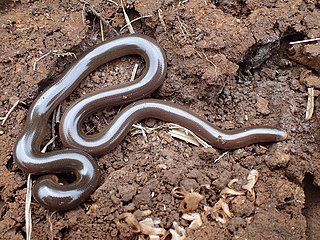Indotyphlops porrectus, the slender worm snake, is a species of harmless blind snake in the family Typhlopidae. The species is endemic to South Asia. There are no subspecies that are recognized as being valid. Not further Study available about this species. Because their number is almost non-existent and their picture has not been recorded yet۔
Uropeltis ceylanica is a species of nonvenomous shieldtail snake in the family Uropeltidae. The species is endemic to the Western Ghats of South India. No subspecies are currently recognized as being valid, but the presence of several synonyms, many recently resurrected, calls for further taxonomic studies of this species complex. It is a burrowing snake with a pointy head equipped to penetrate the soil. It has a thick tail which looks as if it has been cut at an angle. In Kerala it's called iru thala moori, which means two headed organism, as the tail end looks like another head. It primarily eats earth worms.
Uropeltis macrorhyncha is a species of nonvenomous snake in the family Uropeltidae. The species is endemic to India. There are no subspecies that are recognized as being valid.
Uropeltis nitida is a species of nonvenomous shieldtail snake. The species is endemic to southern India. There are no subspecies that are recognized as being valid.
Uropeltis rubrolineata is a species of nonvenomous shieldtail snake in the family Uropeltidae. The species is endemic to southern India. There are no subspecies that are recognized as being valid.

Bothrops ammodytoides is a venomous pit viper species endemic to Argentina. No subspecies are currently recognized.
Letheobia simonii is a blind snake species endemic to the Middle East. No subspecies are currently recognized.

Hypnale nepa, the Sri Lankan hump-nosed viper, is a venomous pitviper species endemic to Sri Lanka where it is known as මූකලන් තෙලිස්සා in Sinhala. Earlier thought that Hypnale walli and Hypnale nepa were two distinct species, but it is now accepted that it is the same species and Hypnale walli is a synonym name. Relatively small, they are distinguished by a strongly upturned snout. No subspecies are currently recognized.

Leptotyphlops nigricans, also known as the black threadsnake or black worm snake, is a species of snake in the family Leptotyphlopidae. It is endemic to Africa.
The brown-snouted blind snake, also known commonly as Wied's blind snake, is a species of snake in the family Typhlopidae. The species is endemic to Australia.
Rhinotyphlops ataeniatus is a species of snake in the family Typhlopidae. The species is endemic to the Horn of Africa.
Rhinotyphlops boylei, commonly known as Boyle's beaked blind snake, is a species of snake in the family Typhlopidae. The species is native to southern Africa.

Rhinotyphlops lalandei, known commonly as Delalande's beaked blind snake, is a species of snake in the family Typhlopidae. The species is endemic to southern Africa.
Letheobia newtoni is a species of snake in the family Typhlopidae.

Rhinotyphlops schinzi, commonly known as Schinz's beaked blind snake, is a species of snake in the family Typhlopidae. The species is endemic to southern Africa.
Letheobia somalica, also known as the highland beaked snake or Ethiopian blind snake, is a species of snake in the family Typhlopidae. It is endemic to Ethiopia.

Bibron's blind snake is a species of snake in the family Typhlopidae. The species is native to southern Africa.
The Bahamian slender blind snake is a species of snake in the family Typhlopidae.
The Malawi blind snake, also known as the slender blind snake or southern gracile blind snake, is a species of snake in the Typhlopidae family. It is endemic to Africa.

Afrotyphlops schlegelii, commonly known as Schlegel's beaked blind snake or Schlegel's giant blind snake, is a species of snake in the family Typhlopidae. The species is endemic to eastern and southern Africa, and bears the distinction of being the world's largest typhlopid. It is harmless to humans and lives exclusively on a diet of termites.






